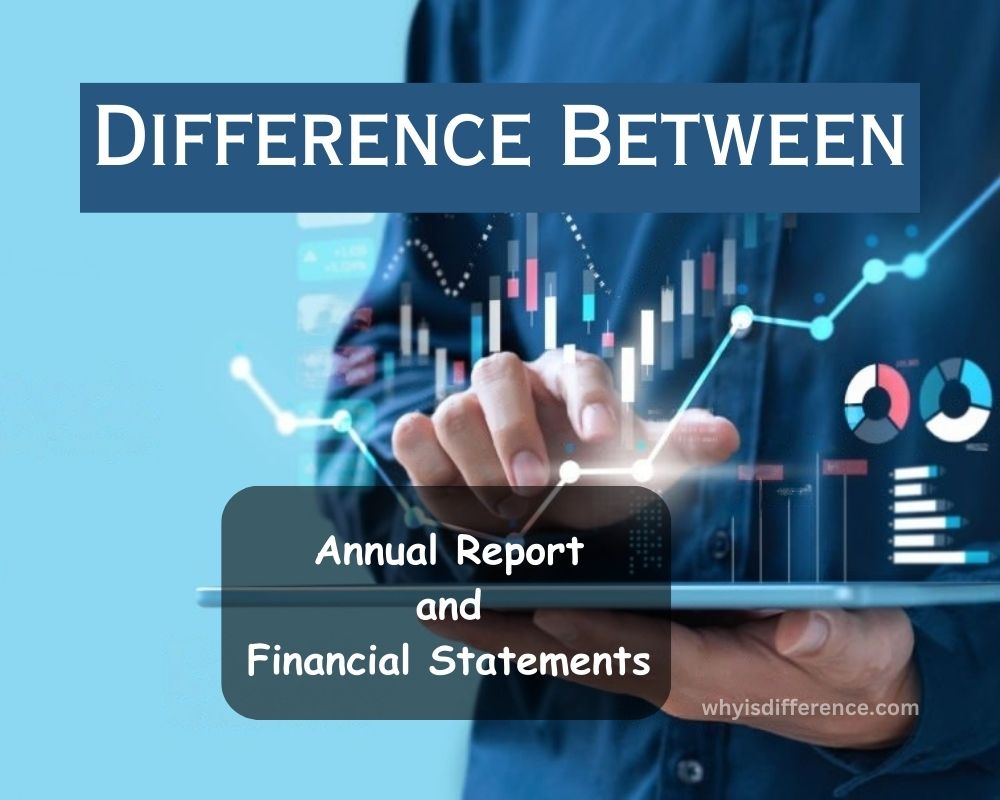Annual Report and Financial Statements: The financial statements of a business are an account of the company's finances. They are structured in such a way that they are easily understandable by everyone, including investors, shareholders, and SEC. A company's annual report contains more information than just financial statements, even though its primary purpose is to give all interested parties all the relevant financial data about the business. There are many similarities between a financial report and an annual report, which confuses some people and leads them to treat the two as one. This is incorrect. The article below will clarify the difference between them to clear up any doubts that readers may have.
A brief overview of the significance of financial reporting
Financial reporting is vital in providing accurate and pertinent information about an organization's performance and financial position. Companies use financial reporting as a way of sharing results and activities with various stakeholders such as creditors, investors, regulators, and members of the public. Financial reporting serves several important functions.
Among others, it helps:
- Financial reporting promotes accountability by disclosing an organization's financial information to its stakeholders, who can then assess its health and performance to make more informed decisions. Financial reporting increases accountability by providing an overview of all financial activities; furthermore, it fosters trust with them.
- They offer crucial information that allows stakeholders to make more informed decisions. Investors use financial statements as tools to assess an organization's health financially; creditors evaluate an entity's creditworthiness against these statements. A sound financial report allows stakeholders to identify risks, evaluate opportunities, and make sound financial decisions.
- Accounting standards, laws and regulations govern financial reporting. This ensures organizations adhere to applicable reporting requirements while creating consistency among entities' financial data. Financial reporting standards also help boost credibility and fairness in reports.
- They enable stakeholders to assess a company's performance over a specific time period. Financial statements such as balance sheets and income statements provide trends analysis as well as financial growth or decline measurements to help stakeholders assess success, efficiency and profitability in an organization.
- Assessment of Risk and Viability - Financial reporting allows stakeholders to accurately assess risks related to an organization's finances. Financial statements allow stakeholders to assess a company's ability to meet its financial obligations, generate profit, manage debt responsibly and efficiently allocate resources - essential elements in making informed decisions regarding investment, partnership or lending arrangements.
Financial reporting is an indispensable tool for facilitating transparency, decision-making, compliance evaluation, performance review and risk evaluation. Financial reporting can help organizations build stakeholder trust while encouraging investment and developing an excellent financial standing.
Importance of understanding the differences between annual reports and financial statements
Understanding the differences between financial statements and annual reports is of great significance for those using financial data to inform their decisions.
Here are some key reasons:
- Annual reports and financial statements contain various levels of information with distinct purposes. Understanding their differences allows stakeholders to gain greater insight into an organization's performance, strategic direction, and finances - giving them a more nuanced picture of an organization's prospects and status.
- The information needs of various stakeholders are diverse. Investors require in-depth financial data on investment before making their final decisions; lenders use financial statements as criteria for creditworthiness determination. Understanding these differences allows stakeholders to access specific information from appropriate sources and make accurate decisions based on all available data.
- Annual reports go beyond providing standard financial statements by offering narrative context that gives stakeholders a full picture. This may include management discussion, analysis, or any other relevant sections relevant to an annual report. These annual reports promote transparency and accountability by giving stakeholders more comprehensive evaluation of an organization's performance than standard reports can do.
- Organizations must abide by regulatory and compliance requirements, with an understanding of these distinctions providing stakeholders the knowledge they need to monitor compliance with them, verify financial statements are being prepared according to guidelines, identify any discrepancies and address potential issues or discrepancies that might exist in financial statements, etc.
- Annual reports often target a wide audience, including employees, shareholders, and potential investors. Stakeholders can effectively interpret and present financial data by understanding its differences - providing accurate communication among them and increasing engagement.
- Financial statements provide a snapshot of an organization's performance and finances, providing stakeholders with essential data that allows them to assess risks involved with investing, lending or partnering up with an organization. Being aware of the difference between annual reports and financial statements helps stakeholders better assess specific information needed for risk assessment and risk management purposes.
Knowledge of the distinctions between an annual report and financial statements allows stakeholders to make better decisions, improve transparency, meet regulations, effectively communicate with others and evaluate risks more accurately. Furthermore, such knowledge provides stakeholders with a fuller picture of their finances allowing them to fulfill their roles more efficiently.
Annual Reports: A Comprehensive Overview

Annual Report Definitions
An annual financial performance report provides a full account of an organization's finances, operations and business in general over one fiscal year. It is prepared by management and distributed to investors, regulators, shareholders and others who might want to know.
An annual report's primary objective is to inform stakeholders of a company's financial status, direction, achievements, obstacles and future outlook. An annual report provides companies with an opportunity to demonstrate accountability while communicating with all of their key stakeholder audiences.
Key Components of an Annual Report
An annual report is typically composed of various components that, combined, give a comprehensive overview of a company's operations and performance.
While its components may differ depending on legal or industry standards, most annual reports generally include:
Chairman's Letter
A letter written by the CEO or chairman of the company serves as its chairman's message and gives personal insight into the challenges, achievements, and goals of the business. This section of the report gives a general overview of business performance while setting the tone for further sections.
Management Discussion and Analysis
This section offers a thorough evaluation of financial statements, key indicators, and market trends and risks, with insight into the strategic initiatives of the company as well as its competitive landscape and industry dynamics. Additionally, stakeholders can gain an understanding of which factors have an effect on its financial performance and future prospects.
Financial Highlights
This section presents an overview of the key results achieved by your business during the last year, such as revenue and net income figures as well as other essential metrics like earnings per share or return on investment returns. This enables stakeholders to quickly understand its financial performance.
Corporate Governance information
The corporate governance section of our website offers information regarding governance structure, board composition, practices and executive compensation of CEO and board. In addition, this section also addresses ethics/ethical business practices within companies; thus demonstrating their dedication towards good corporate governance practices. The goal is for this section to illustrate the commitment that each company demonstrates toward good corporate governance practices.
Audited Financial Statements
Audited financial reports are an integral component of an annual report. This includes both the balance sheet and income statement as well as cash flow statements, changes in equity statements, and statements on cash flow statements that provide insight into a company's assets, liabilities, and revenues. All audited statements prepared according to generally accepted accounting practices (GAAP) have been thoroughly checked and verified by an independent auditor before being included in an annual report.
C. Explanation of each Component in Detail
An annual report plays an integral role in providing a holistic overview of a company's operations and performance while providing diverse information and perspectives to stakeholders that enable them to gain a better understanding of the financial, governance, and strategic aspects of any given organization. We will examine each component more thoroughly below; exploring its importance and function within an annual report.
Over the following sections, we will discuss each component of a report in depth. These components include the Chairman's Letter, Management Discussion and Analysis (MD&A), financial highlights, corporate governance practices, and audited financial statements.
Financial Statements: The Foundation of Reporting

Definition and Function of Financial Statements:
Financial statements of an organization provide a concise snapshot of its performance and finances at any point in time. Produced at the end of each accounting period, these documents offer important insight into a company's current state, profitability, and liquidity - vital information needed by stakeholders when making decisions.
B.B. Different Types of Financial Statements
Four main forms of financial reporting are often employed within financial reporting.
A Balance Sheet or Statement of Financial Position is used to display the state of an entity's finances at any point in time.
Balance sheets provide a snapshot of a business's financial condition at any particular moment in time, outlining assets, liabilities and equity for an entity. Balance sheets give insight into its solvency, liquidity, and capital structure.
Income Statement
An Income Statement provides an overview of a company's revenue, expenses, profits and losses over a given timeframe (typically an fiscal year), to illustrate their ability to turn a profit or experience losses and enable stakeholders to assess its profitability and performance.
Cash Flow Statement
A cash flow statement provides information about cash inflows and outflows related to the operating, investment, and financing activity of an enterprise. This financial document shows information such as cash generated by its operations; ability to meet financial obligations; cash management strategies used; generation of new cash; generation of revenue for its products/services offered - making a valuable aid when analyzing a company's cash flow and liquidity position.
Statement of Equity Changes
Statement of Changes in Equity provides a snapshot of changes to shareholders' equity during a specified period. It reflects transactions such as new share issuance, dividends, net income and accounting policy adjustments; additionally, it gives an overall picture of changes to shareholders' equity including contributions, dividends and retained earnings.
Explaining Financial Statements and Their Components
Financial statements serve a vital function, providing a unique insight into an organization's financial health. Here is an overview of their use.
Balance Sheet
A balance sheet displays all of a company's assets (current and long-term), liabilities (both current and long-term obligations) as well as shareholders equity. This document gives stakeholders insight into its liquidity and solvency status, giving stakeholders an accurate assessment.
Income statements provide an overview of a company's revenues, expenditures, profits, losses and profits for any given period. They allow stakeholders to assess a business's profitability, operational efficiency and trends as well as understand what impacts its operations and trends might be.
Cash Flow Statement
A cash flow statement provides stakeholders with information on cash sources and uses, helping them assess a company's cash generation and liquidity as well as ability to meet financial commitments. In addition, this report displays the investment and finance activities of that same company.
Changes to Equity Statement
Statement of Changes in Equity provides an accounting of changes to shareholders' equity during a specified period. This statement includes details such as new share issuance, dividends paid out, and net income adjustments as well as accounting policy adjustments and accounting policy modifications that impact shareholders' equity and capital structure changes.
By understanding each financial statement and its components, stakeholders can analyze and interpret a company's financial position and performance. Financial statements play an integral role in making decisions, assessing risks, and gauging an organization's overall health.
Key Differences Between Annual Reports and Financial Statements
Understanding the differences between financial statements and annual reports is vital in order to fully appreciate their unique purposes, scope and contents. Here are the key distinctions between them:
Financial Statements
Financial statements provide an organization with a snapshot of its performance and cash flow over a specific time period (usually one year). Financial statements serve three main functions; to comply with regulatory requirements, present accurate information to stakeholders, and assess the financial health of an organization.
Annual Reports Annual reports provide more than just numbers; they cover a broad array and encompass much more. Annual reports offer an overview of the financial performance of a company as well as its strategic direction, achievements in operations, and challenges facing it in future challenges and prospects. Annual reports aim to inform shareholders, investors, and stakeholders regarding all aspects of business operations governance and finances and are addressed as such.
Financial Statements
Financial statements are designed for stakeholders with an avid interest in financial data, including investors, lenders and analysts. They enable these stakeholders to assess risk when making investment or lending decisions or complying with regulatory requirements.
Annual reports are written with a wide audience in mind, including shareholders, investors, potential employees, clients, suppliers and members of the public in mind. Their purpose is to give an overall picture of an organization's financial and operational performance; rather than only offering financial information it reaches further afield than those interested solely in numbers. Annual reports can serve as powerful communication vehicles to convey corporate strategy, social responsibility programs and image.
Level of Detail and Presentation
Financial Statements - Financial statements are standardized and structured formats of financial information that provide details on an organization's income, cash flow and equity changes. When prepared by an organization based on accounting principles that follow standard formats; they allow comparison among organizations.
Annual ReportsAnnual reports include not only financial statements but also feature narrative sections to provide context and analysis on business performance and strategy. Visual elements like charts, graphs, or case studies may be included to improve readability and give an overall picture of an organization's activities.
D. Requirements and Compliance
Financial Statements. Financial statements must abide by specific accounting principles and regulations, such as the Generally Accepted Accounting Principles or International Financial Reporting Standards. These standards ensure that reports from organizations across jurisdictions have equal consistency and comparability.
Annual Reports. Annual reports do more than simply conform with accounting standards; legal and regulatory obligations vary between jurisdictions, and some require certain sections, like corporate governance information or chairman's letters, be included to ensure accountability and transparency.
Reporting frequency and timing
Financial Statements Financial statements should be prepared on either a quarterly or an annual basis, depending on regulatory requirements, stakeholder needs and organizational capabilities. An organization's financial statements must accurately represent its current state while remaining current.
Annual reports provide an overview of an organization's performance over an entire fiscal year, from both its financial and operational perspectives. Released after its financial statements have been published, annual reports outline highlights from both areas.
Complementary Relationship: How Annual Reports and Financial Statements Interrelate
Annual reports and financial statements provide stakeholders with insight into a company's operations and strategy, giving them a comprehensive view of its operations and strategy. Although each document serves a separate purpose and content, their relationship is complimentary as each document adds value to one another. So how exactly do annual reports and financial statements interact?
Financial Statement as the Basis
Annual reports rely on financial statements as their foundation, providing quantitative data to support narratives and analyses presented within them. Statements like an organization's income statement, balance sheet, cash flow statement and statement of change in equity provide structured yet standard representations of its performance and standing.
Financial data contextualization
Annual reports provide more than financial statements alone: they offer qualitative analyses and information that provides context to financial results, while outlining key influences that affected them. Management discussions and analyses (MD&As) are often included to help stakeholders better comprehend financial statements, trends, strategic initiatives, risks and the organisation's risk profile.
Communication and Transparency are Key aspects of success for any successful relationship
An annual report provides organizations with an invaluable tool to communicate with its stakeholders and present an accurate overview of their activities. All financial data is presented clearly with visuals without using technical terms like financial statements; an organization can share its achievements, future plans and challenges with its audience through this communication, building trust and transparency at once.
Link between strategy and financial performance
An annual report serves to bridge the gap between an organization's financial performance and strategic goals, providing insight into the effects of strategic initiatives on long-term performance and sustainability. Discussions regarding how strategic goals align with financial objectives may also be included, helping stakeholders better comprehend this relationship between strategy and results.
Compliance with Regulatory and Legislative Requirements
Annual reports and financial statements both serve to meet compliance. Financial statements must adhere to specific regulatory and accounting requirements in order to remain accurate, consistent and comparable, while certain sections and disclosures included in annual reports may need to meet additional legal or regulatory regulations. Together these documents help organizations comply with reporting obligations and meet compliance.
Organizational Perspective of Holistic Growth
Annual reports provide stakeholders with a holistic overview of an organization by combining financial information with other data and analyses. They allow stakeholders to assess not only financial position and performance but also broader issues like corporate governance, sustainability, and risk management. By including non-financial data alongside financial details, annual reports help increase understanding among stakeholders.
Annual reports and financial statements work hand in hand to provide stakeholders with an in-depth knowledge of an organization's financial performance, strategy, operations, and overall health. While annual reports offer qualitative data for analysis purposes; financial statements provide key foundational elements needed for informed decision-making by stakeholders while simultaneously assessing the health status of an entity.
Conclusion
Annual reports and financial statements could cover various aspects of the operation. They are nevertheless beneficial in aiding investors and shareholders in making proper decisions regarding the business and its future direction. In order to be successful, companies must be attentive to both. Find a reputable and experienced accountant to handle your financial records. This will ensure that your reports are up-to-date and accessible to the entire team on time. Also, outsource and reduce time and cost.

